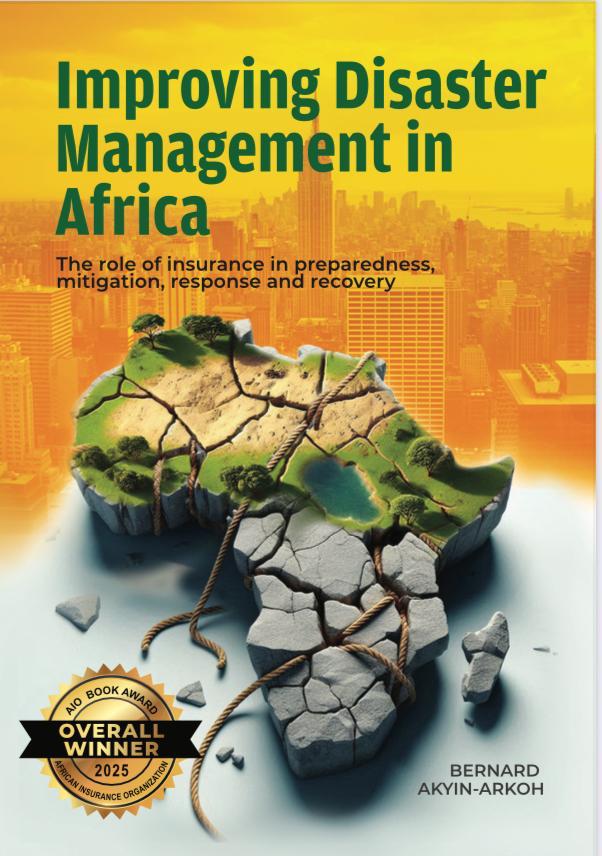
🌍 Award-Winning Publication – Improving Disaster Management in Africa: The Role of Insurance in Preparedness, Mitigation, Response and Recovery is the proud overall winner of the 2025 African Insurance Organisation (AIO) Book Award, a recognition that underscores its significance and impact in shaping conversations on resilience across the continent.
This book explores how insurance can enhance disaster resilience across Africa. It examines the continent’s increasing vulnerability to both natural and human-induced disasters and highlights the gaps in preparedness, mitigation, response, and recovery efforts.
More than just an academic study, this groundbreaking work is a well-researched academic and practical resource designed to:
- Educate students and professionals on the critical role of insurance in disaster management.
- Bridge the gap between theory and practice through real-life African case studies.
- Support governments, the private sector, and academia in advancing the discourse on building a more resilient Africa.
The book is structured into ten comprehensive chapters, each addressing a core area of disaster risk management through the lens of insurance. It provides both a foundational knowledge base and actionable strategies for resilience-building, making it an indispensable resource for policymakers, practitioners, researchers, and development partners.
Chapter One: It provides an overview of the African insurance industry. It explores the historical development of insurance across the continent, key players and regulators, the range of insurance products offered, and the emerging trends redefining the industry. The chapter also discusses the critical role insurance plays in promoting economic stability and growth in Africa, examines persistent challenges and highlights untapped opportunities for expansion. Data-driven insights and figures give readers a broad picture of the industry’s current state.
Chapter Two: This chapter delves into understanding disaster risks in Africa. It defines the various types and forms of disasters common to the continent ranging from floods and droughts to epidemics and conflict-induced crises and discusses the causes, frequency and geographical distribution. This chapter also presents an overview of the economic, social and environmental impacts of disasters, while reflecting on recent global and regional loss trends. It concludes by addressing the ongoing challenges that African countries face in managing disasters effectively.
Chapter Three: This chapter focuses on the growing impact of climate change on disaster risks in Africa. It explains the causes and manifestations of climate change, details shifting weather patterns across African regions and outlines their implications for disaster frequency and intensity. The chapter includes key declarations such as the Nairobi Declaration on Climate Change (2023) and the African Youth Declaration for Climate Mobility (2022). It also introduces concepts like Environmental, Social and Governance (ESG) frameworks and explores barriers to climate change adaptation in Africa.
Chapter Four: This chapter highlights the role of insurance in disaster preparedness. It explains the preparedness phase of disaster management and explores how insurance products and strategies can provide financial resilience before a disaster strikes. The chapter discusses pre-disaster financing tools, risk awareness, community outreach, and the importance of risk pools, reinsurance schemes, and early warning systems in reducing vulnerabilities.
Chapter Five: Chapter five of the book turns the spotlight on the role of insurance in disaster mitigation. It defines mitigation in the context of disaster management and explains how insurance mechanisms such as parametric insurance and underwriting risk controls can drive behavior change and investment in loss prevention infrastructure. This chapter underscores the importance of incentivizing proactive risk-reduction actions before disasters occur.
Chapter Six: This chapter explores the role of insurance in disaster response and recovery. It introduces the concept of post-disaster intervention and provides insight into how insurance supports rapid recovery through claims management, liquidity provision and business continuity. The chapter discusses real examples of disaster payouts and presents the claims management process as a core part of disaster resilience in African communities and economies.
Chapter Seven: The seventh chapter of the book outlines the critical roles played by governments and insurance regulators in disaster risk management. It highlights the need for strong policy frameworks, public-private partnerships, and regulatory support for innovative risk financing tools. It also explores how governments can lead national risk assessments and integrate insurance strategies into broader disaster management policies.
Chapter Eight: This chapter of the book discusses the contribution of international organizations and donor agencies in supporting Africa’s disaster management efforts. This chapter covers partnerships with institutions such as the African Risk Capacity (ARC), the World Bank, UNDP and other global players, while examining the challenges that often limit the effectiveness of external support. It emphasizes the importance of aligning donor aid with sustainable and locally led insurance-based solutions.
Chapter Nine: This chapter presents best practices that are shaping disaster management in Africa. It explores successful microinsurance initiatives, public-private collaborations and the use of technology such as mobile insurance platforms and satellite data in improving disaster response. The chapter also features effective strategies by governments and regulators and highlights innovative awareness campaigns that promote community preparedness.
Chapter Ten: Chapter Ten offers actionable recommendations for improving disaster management on the continent. It provides tailored suggestions for governments, regulators, insurers, development partners, and academic institutions. These include enhancing policy frameworks, building financial literacy, adopting digital innovations, expanding microinsurance, and strengthening public engagement. The chapter closes with a call to action for collective responsibility and long-term investment in Africa’s disaster resilience.
Why This Book Matters
This award-winning book is a timely contribution to Africa’s journey toward resilience. By combining rigorous research, African case studies, and practical recommendations, it charts a roadmap for leveraging insurance as a cornerstone of disaster management. It is not only a resource but also a call to action for collective responsibility and sustainable investment in Africa’s future.
- For individuals: the book builds awareness of how disasters affect livelihoods and demonstrates how insurance can serve as a practical tool for personal and community resilience. It empowers readers with knowledge to make informed decisions about risk protection.
- For institutions (academia, private sector, NGOs): the book serves as a teaching and training resource, a reference for research, and a guide for designing innovative products and solutions that address Africa’s unique disaster challenges.
- For governments and policymakers: the book provides insights into policy frameworks, financing tools, and regulatory measures that can strengthen national disaster preparedness, mitigation, response, and recovery systems.
In essence, this book is for anyone who seeks to understand and contribute to building a disaster-resilient Africa—whether as a student, professional, policymaker, or development partner.

